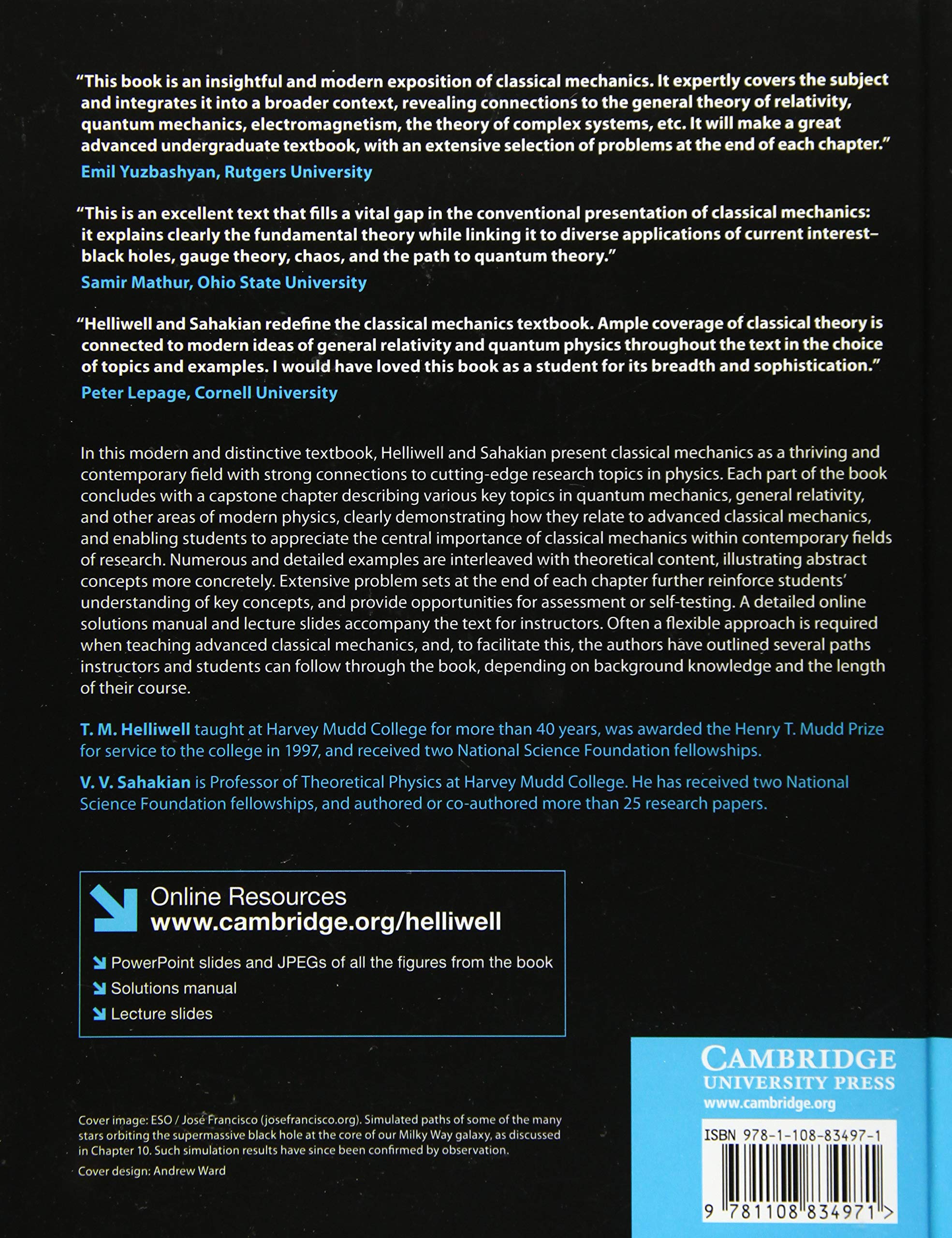


Modern Classical Mechanics
A**N
Excellent second text on classical mechanics
This is the first more advanced classical mechanics text which clicked for me. The pre-requisites are really just a first year mechanics background with knowledge of solving Newton's equations in various typical situations. The textbook is split into 3 parts each of which contains core analytical mechanics parts and ends with more nuanced materials that sets one up for better appreciation of some more advanced topics. The writing is clear and the topic range is broad. The exercises are numerous and range from easy to more challenging. But I think this is an excellent book for self-study after which more formal texts become substantially more approachable.As mentioned the book is split into 3 parts, the first starts out with a review of 1st year mechanics and relativity and moves into concepts in the calculus of variations. So one gets a quick refresher and then things get into new territory. One moves into Lagrangian mechanics first at a first introduction level discussing how to think about generalized coordinates and momentum. There is an ending section on wave concepts and a high level introduction to concepts that carry over into Quantum mechanics. The second part is the most important part of the book where the authors thoroughly cover Lagrangian dynamics and its details. Noether's theorem is proved with clarity rather than the typical formal computation that usually is used to justify it. The author discuss Lagrange multipliers and their use in deducing the actual constraint forces that are otherwise ignored if certain generalized coordinates can avoid them. The authors revisit central forces and rotationally invariant systems and their conserved quantities. Electromagnetism within the Lagrangian framework is introduced as is the generalized momentum that includes the vector potential. The authors give a first introduction to rotating frames and fictitious forces. The notation on some tensor concepts is a bit strange but the concepts are well explained. The second section discusses some concepts from relativity and introduces how extremum principles are used for calculating motion with the Schwarzschild Metric. Both brownian motion and gauge symmetry are also discussed briefly. The third section is an introduction to Hamiltonion mechanics. The coverage of the Legendre transformation is excellent as is the coverage of the Poisson Brackets. Canonical Transformations is discussed but I think there is better coverage elsewhere. The topics covered earlier in rotating frames is re-discussed in the domain of Rigid Body Dynamics and Euler angles are introduced and discussed clearly. The authors then discuss coupled oscillators which is usually a topic that can be discussed much earlier as it is really a linear algebra problem that is much easier than the topics covered earlier in the book but as with most of the writing, it is a good discussion. The last 2 chapters of the book are quite advanced with nonlinear dynamical systems as well as how quantization fits in. I would say they both give a good flavor of the topics but they are just overviews for which one can feel slightly more prepared once one takes higher level classes on the topics.Overall I really rate the material in this book. The problems I think could have been a bit better, there is a star system of between 1 to 3 with one being the easiest. There are times where the problems are out of order, for example they ask some gauge symmetry questions about gauges they introduce several chapters later. Also the problems are largely word problems rather than specified in more mathematical form so at times its a bit annoying to translate the question into the drawing that should have been there to accompany it. Despite the problems needing a bit of editing the text does not and overall I am a big fan of this book.
T**S
a wonderful book
Okay, now that I have spent a few months with this book, I feel qualified enough to write a review. Helliwell and Sahakian's intended use for this book is that of an advanced undergraduate mechanics course. Years ago, when I took my second course in mechanics, we used John R. Taylor's Classical Mechanics, which is excellent and I loved. That said, I wish we had used this book instead.Helliwell & Sahakian have a myriad of worked-out examples and even more problems for practice. (Admittedly, I have not done as many of the problems as I could/should have, so there's that caveat to this review.) Perhaps it's because I struggled with it as a student, but whenever I look at a new mechanics book, I look at its section on rigid-body motion in depth. After comparing Taylor's with Helliwell & Sahakian's, I prefer this book's treatment. By and large, I feel that way on the whole.In addition to its clear treatment, what I like in particular about this book is that (1) it emphasizes geometry which will be useful in a physicist's later career, and (2) it explicitly makes the connections as to where classical mechanics fails, i.e. where quantum or relativistic effects begin to play a role. In many ways, this book feels to me like a worthy prerequisite to Thorne & Blandford's recent tome, Modern Classical Physics.In all, I highly recommend this book. As it did for me, I think it will exceed expectations.
C**Z
Great for classical mechanics, also builds bridges toward quantum mechanics
there's also some relatives in there
A**R
Good book for an advanced undergraduate Coursera.
This iwas a nice addition to my Mechanics book collection. 🤓🤓🤓
Trustpilot
1 day ago
2 weeks ago